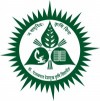| About Project | ||
| Mandate | ||
| Research Activities and Achievements | ||
| Research Highlights | ||
| Transfer of Technologies | ||
| Scientists | ||
| Contact Information |
About Project
The role of improved farm implements and machinery, for sustainable development of agriculture and enhancement of productivity, has been established beyond doubt. They help to achieve timeliness of farm operations and efficient use of other inputs such as HYV seeds, chemicals, fertilizer and water. Under dynamic situation of changing cropping pattern as influenced by local agro-socio-economic factors, identification of farm mechanization needs and development of need-based farm implements and machinery are of paramount importance.
For development, testing and popularization of need-based farm implements and machinery for different regions of the country, the ALL India Coordinated Research Project (AICRP) on Farm Implements and Machinery (FIM) was started by Indian Council of Agricultural Research in 1975 during V Five Year Plan with six Centers. There are now 25 centers working on two or more of the five distinct activities under the project, namely, design and development, prototype manufacturing, prototype feasibility testing, front line demonstration and power tiller technology. The FIM center at Dr. P.D.K.V., Akola is started on February 01,1997. Under this FIM center prototype feasibility testing, front line demonstration activities are undertaken.
Mandate
To identify the mechanization gaps and future needs of improved farm tools and equipment for different agro-climatic regions, crops and operations, and conduct research and development, prototype production, feasibility testing, frontline demonstration and promotion of manufacturing through industrial extension.
AICRP on FIM Dr. P.D.K.V., Akola centre is working on prototype feasibility testing and front line demonstration activitiesnt.
Infrastructure
All India Co-ordinate Research Project on Farm implements and Machinery Dr. P.D.K.V., Akola Centre, is situated at Faculty of Agricultural Engg., Dr. Panjabrao Deshmukh Krishi Vidyapeeth, Akola (M.S). Under this center the two tractors and different types of farm equipments and machineries are available which are kept in farm machinery yard of Department of Farm Power and Machinery, Dr. P.D.K.V., Akola.
Research Activities and Achievements
Under this FIM center prototype feasibility testing and front line demonstration activities are undertaken.
The activity on Prototype Feasibility Testing (PFT) includes:
- Mechanization studies to identify crops and operations for which improved machines are required.
- Identification of designs of farm implements and machinery which can be adopted to fill the identified mechanization gaps.
- Procurement and feasibility testing of identified equipment on farmers field and their adaption under local agro-climatic conditions.
- Popularization of adapted farm implements and machinery among farmers and promoting their manufacture by involving local manufacturers. Machinery is undertaken.
The activity on Front Line Demonstration (FLD) of improved farm equipment includes:
- Adapt new designs of farm equipment to bridge identified mechanization gaps
- Test the efficacy of the identified equipment
- Popularize and commercialize the identified equipment and
- Obtain feedback from farmers for design refinement of the selected farm equipment.
Research Highlights (Prototype Feasibility Testing)
A. Project Title: Prototype feasibility testing of tractor operated three row rotary weeder
| The tractor operated rotary weeder was used in cotton and pigeon pea crop at different growth stages. The weeder work satisfactorily during operation. The average field capacity of the weeder was found to be 0.42 ha/h. The average weeding efficiency of the weeder, fuel consumption and cost of working was found to be 94.16 %, 4.9 lit./h. and 675.0 Rs./h. respectively. The saving in time is observed to be 87.61 percent when compared with farmer practice i.e use of animal drawn blade hoe. | 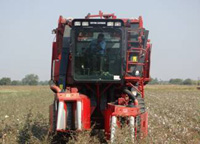 |
B. Project Title: Prototype feasibility testing of self propelled vertical conveyer reaper
| The self propelled vertical conveyor reaper was tested for harvesting soybean crop in the field. The average effective field capacity and field efficiency of the self propelled vertical conveyor reaper was found to be 0.28 ha/h and 88.16 % respectively. Fuel consumption of self propelled vertical conveyor reaper was 0.72 lit/h. It was observed that at lower grain moisture content the percent harvest losses were higher. | 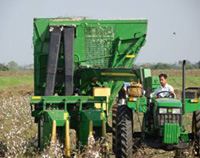 |
C. Project Title: Prototype feasibility testing of self propelled reaper binder
| The testing of self propelled reaper binder was carried out for harvesting of wheat and paddy crop. The average effective field capacity and field efficiency of the self propelled reaper binder was found to be 0.36 ha/h and 91.76 % respectively. In case of wheat crop the saving in the cost of operation and time are 45.21 % and 98.0 % respectively. In case of paddy crop average effective field capacity and field efficiency was 0.20. ha/h and 57.77 % respectively. | 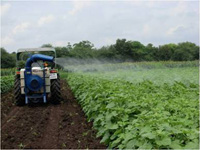
|
D. Project Title: Prototype feasibility testing of tractor operated horizontal air sleeve sprayer
| The self propelled vertical conveyor reaper was tested for harvesting soybean crop in the field. The average effective field capacity and field efficiency of the self propelled vertical conveyor reaper was found to be 0.28 ha/h and 88.16 % respectively. Fuel consumption of self propelled vertical conveyor reaper was 0.72 lit/h. It was observed that at lower grain moisture content the percent harvest losses were higher. |  |
E. Project Title: Prototype feasibility testing of tractor operated roto till drill.
| The average effective field capacity and field efficiency of the tractor operated roto till drill was found to be 0.35 ha/h. and 77.17 %. The average fuel consumption was 6.77 lit/h. In case of farmers practice the field preparation by blade harrow and sowing by seed drill is done separately. Whereas in case of roto till drill both the operations are done simultaneously. Hence there is 35.08 percent saving in time of operation. |  |
F. Project Title: Prototype feasibility testing of self propelled fodder harvester for soybean
| The self-propelled fodder harvester was tested for harvesting soybean crop in the field. The average effective field capacity and field efficiency was found to be 0.29 ha/h and 86.89 % respectively. The harvest loss was 4.79 percent The effective field capacity of the self propelled fodder harvester is very high as compared to manual harvesting of soybean crop because which there is about saving in time of operation. |  |
Transfer of Technologies
Front Line Demonstrations:- Under this activity the demonstrations of various farm equipments were given. The equipments such as Tractor drawn BBF planter, light weight power tiller, rotavator, seed drills, threshers etc. are demonstrated to the farmers.
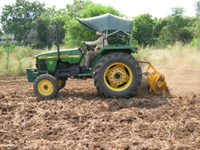 |
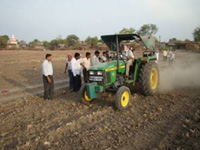 |
|
| FLD of Rotavator
|
||
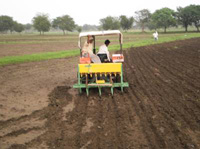 |
 |
|
| FLD of Seed Drill
|
||
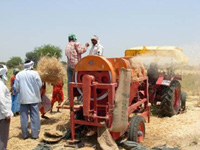 |
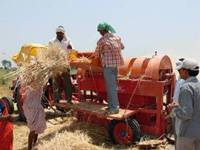 |
|
| FLD of Multicrop Thresher | ||
Contact Information
Er. Avinash V Gajakos
Senior Scientist
All India Coordinated Research Project on Farm Implements and Machinery,
Department of Farm Power and Machinery,
Dr. PDKV, Akola 444 104 MS India
Phone(Office) :0724-2258405
